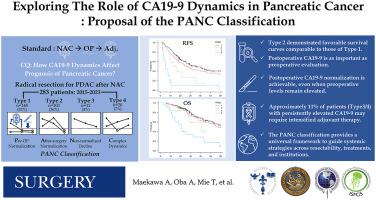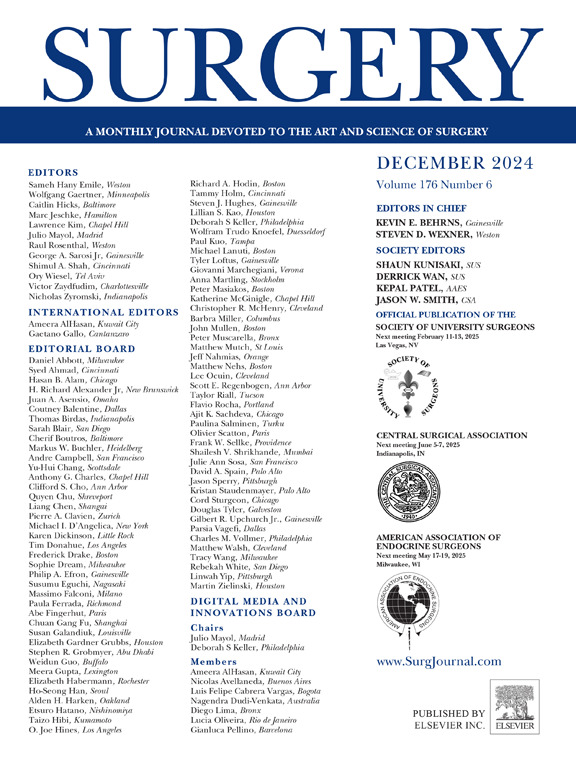探讨CA 19-9动态在胰腺癌多学科治疗中的作用:PANC分类的提出
IF 2.7
2区 医学
Q1 SURGERY
引用次数: 0
摘要
背景:多药化疗的进步已经改变了胰腺癌作为全身性疾病的治疗方法,手术在决定预后方面起着至关重要的作用。血清碳水化合物抗原19-9仍然是评估治疗反应和指导临床决策的最重要的生物标志物。本研究旨在评估化疗和手术前后碳水化合物抗原19-9的动态,以优化治疗策略并改善患者预后。方法回顾性分析术前化疗后行根治性手术的胰腺癌患者。根据化疗前后及术后碳水化合物抗原19-9的反应模式,建立PANC分型并评估其预后意义。结果283例患者中位总生存期为56.3个月,无复发生存期为26.0个月。PANC分类如下:1型(术前正常化)148例(52.3%),2型(术后正常化)103例(36.4%),3型(非正常化衰退)12例(4.2%),4型(复杂动态)20例(7.1%)。1型和2型反应与良好的总生存期(61.1个月和57.8个月)和无复发生存期(35.0个月和25.6个月)相关,而3型和4型反应与较差的结果相关。多变量Cox比例风险模型将1型和2型(相对于3型和4型)确定为独立的预后因素(风险比= 3.20;95%可信区间为1.99-5.16;P < .001)以及其他重要因素。结论PANC分类为碳水化合物抗原19-9动态分类提供了一个实用的框架。它可以很容易地与不同机构和地区的各种治疗策略相结合,最终改善患者的治疗效果。本文章由计算机程序翻译,如有差异,请以英文原文为准。

Exploring the role of CA 19-9 dynamics in pancreatic cancer multidisciplinary treatment: Proposal of the PANC classification
Background
Advancements in multiagent chemotherapy have transformed the management of pancreatic cancer as a systemic disease, with surgery playing a crucial role in determining prognosis. Serum carbohydrate antigen 19-9 remains the most critical biomarker for assessing treatment response and guiding clinical decisions. This study aimed to evaluate carbohydrate antigen 19-9 dynamics around chemotherapy and surgery to optimize treatment strategies and improve patient outcomes.
Method
We retrospectively analyzed pancreatic cancer patients who received preoperative chemotherapy followed by radical resection. Based on carbohydrate antigen 19-9 response patterns before and after chemotherapy, as well as after surgery, we established the PANC classification and assessed its prognostic significance.
Results
Among 283 patients, the median overall survival was 56.3 months, and recurrence-free survival was 26.0 months. The PANC classification categorized patients as follows: type 1 (Preoperative normalization), 148 patients (52.3%), type 2 (After-surgery normalization), 103 patients (36.4%), type 3 (Non-normalized Decline), 12 patients (4.2%), and type 4 (Complex dynamics), 20 patients (7.1%). Type 1 and 2 responses were associated with favorable overall survival (61.1 and 57.8 months) and recurrence-free survival (35.0 and 25.6 months), whereas type 3 and 4 responses were associated with poorer outcomes. A multivariate Cox proportional hazard model identified types 1 and 2 (versus types 3 and 4) as independent prognostic factors (hazard ratio = 3.20; 95% confidence interval, 1.99–5.16; P < .001) along with other important factors.
Conclusions
The PANC classification provides a practical framework for categorizing carbohydrate antigen 19-9 dynamics. It can be easily aligned with diverse treatment strategies across various institutions and regions, ultimately improving patient outcomes.
求助全文
通过发布文献求助,成功后即可免费获取论文全文。
去求助
来源期刊

Surgery
医学-外科
CiteScore
5.40
自引率
5.30%
发文量
687
审稿时长
64 days
期刊介绍:
For 66 years, Surgery has published practical, authoritative information about procedures, clinical advances, and major trends shaping general surgery. Each issue features original scientific contributions and clinical reports. Peer-reviewed articles cover topics in oncology, trauma, gastrointestinal, vascular, and transplantation surgery. The journal also publishes papers from the meetings of its sponsoring societies, the Society of University Surgeons, the Central Surgical Association, and the American Association of Endocrine Surgeons.
 求助内容:
求助内容: 应助结果提醒方式:
应助结果提醒方式:


